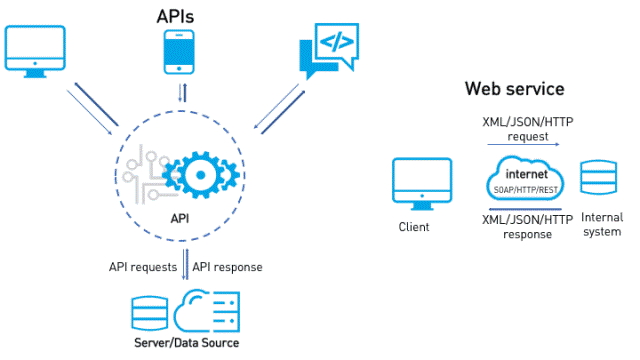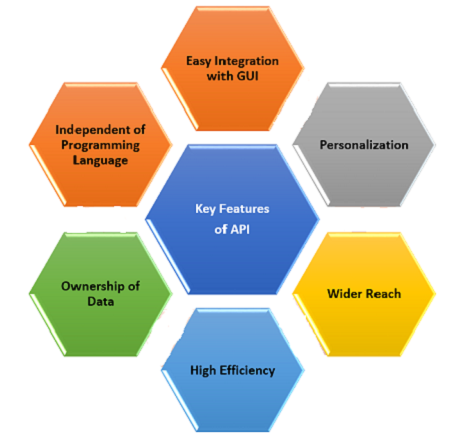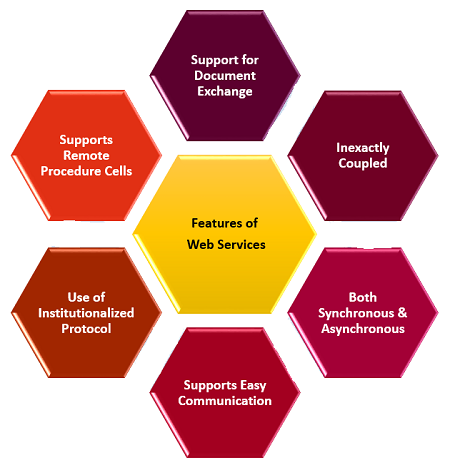API vs Web Service: Understanding the Difference
.png)
APIs and Web Services both serve as platforms for interactions between systems or applications. Interestingly, many of us often tend to get confused between the two overlapping terms and it’s very common to use these terms interchangeably. However, the fact is that these two are different concepts and, in this blog, you’ll discover the difference between the two, based on the advantages, features and basics about each one.

Source: https://bit.ly/3axbPa9
1] API
An API, or Application Programming Interface, is a term used to denote a set of definitions and protocols that allow one application to interact and communicate with another application. Today, the term API is used to refer to Web APIs.
a] Advantages
The following are the advantages of API:
- Through API’s rather than people computer machines can manage the work, as it enables the automation.
- It works with HTTP verbs GET, PUT, POST and DELETE and supports the CRUD operations.
- APIs can access the app components and the delivery of services and information is more flexible.
- Using APIs any user or company can customize the content and services that they use the most.
- APIs make service provision more flexible.
b] Features
The following diagram illustrates the key features of an API.

c] Disadvantages
The following are the drawbacks of using API:
- API is an expensive in terms of development time, ongoing maintenance and providing support to users of your API.
- API creation is a time-consuming process
- To use API, requires knowledge of programming languages
- API testing often leads to system crashes
2] Web Services
A web service facilitates communication between two machines over a network using a protocol.Web service is a collection of open source protocols and standards that are frequently used for exchanging data between systems or applications. Web services commonly use HTTP as a means of connectivity between two systems and can be invoked by sending a request, which is usually in the form of an XML message, but can also be JSON, XML, an HTML file, or even images, audio files, etc.
a] Advantages
The following are the key benefits of Web Services:
- Web services are less expensive to use
- XML, WSDL, UDDI, HTTP standards are used for application to application interaction, which solve many communication problems.
- It supports usage as a web page request for receiving data.
- Web servicesserves as a channel for faster communication within an organization as well as outside it.
- Independent existence that is not dependent on other services.
- Facilitates easy exchange of data between different applications and platforms.
- Provision for shared services among applications, along with data exchange and communication.
- Web services facilitates applications to publish application messages.
- Provision for interlinking of data among applications which resolves interoperability issues and gives highest priority to interoperability.
b] Features
The following diagram illustrates the key features of Web Services

c] Disadvantages
The following are the drawbacks of Web services:
- Need for specialized machine requirements for creating a service.
- No provision to leverage the latest web developments (semantic Web, AJAX, XML, etc.)
- Uses the HTTP protocol, which is not always reliable, which sometimes leads to failure of response delivery.
Key Differences at a Glance: API vs Web Services
Now that we have learnt about the basics of API and Web Services, let us have a quick look at the key differences between the two.
It’s important to note that All Web Services are API but NOT all APIs are Web Services
| Parameter | API | Web Services |
| Definition | API is Application Programming Interface. It’s a term used to denote a set of definitions and protocols that allow one application to interact and communicate with another application. | A collection of open source protocols and standards that are frequently used for exchanging data between systems or applications. |
| Accessibility | Not all APIs are accessible over a network | Must always be accessed through a network |
| Format supported | Supports XML, JSON, or any other given format. | Supports XML format. |
| Architecture | Has a lightweight architecture. | Data can be sent or received over a network using the SOAP protocol. Architecture not lightweight. |
| Style of communication | Supports any style of communication. | Uses REST, SOAP & XML-RPC for communication. |
| Protocol supported | Provides support for the HTTP/s protocol. | Provides supports only for the HTTP protocol. |
Glossary
Here’s a list of terms used above for your quick reference.
HTTP: It stands for HyperText Transfer Protocol which forms the foundation for transferring data and communication on the World Wide Web.
SOAP:It stands for Simple Object Access Protocol and it’s a messaging protocol that helps in exchangingthe structured information on network.
REST: It stands for REpresentational State Transfer which is a standardized architectural pattern used only in the creation a web API.
XML: It stands for eXtensible Markup Language which is standardized format used to store and send data. It wraps data in descriptive tags for storage, just like HTML does.
JSON: It stands for JavaScript Object Notation which also helps users store data and send it in a standardized format, just like XML does.
Web App: A web app or web application is a program that can be accessed through a web browser.
So, that was about the key differences between an API and Web Services. We can conclude that while both are overlapping in some ways, there are certain distinct differences between the two.

